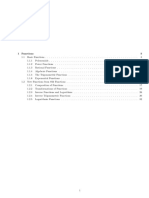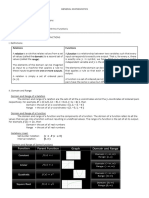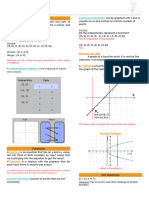Introduction to Functions in Mathematics
A function is a relation between a set of inputs and a set of possible outputs where each input
is related to exactly one output. Functions are fundamental in mathematics because they
describe how one quantity changes in relation to another.
Notation: A function is usually written as f(x), where f is the function name and x is the input
(independent variable). The output is f(x), called the dependent variable.
Example: If f(x) = x², then for input x = 3, the output is f(3) = 9. This function takes a number
and squares it.
Domain and Range: - The domain of a function is the set of all possible inputs (x-values). -
The range is the set of all possible outputs (f(x)-values).
Graph of a Function: Functions can be represented visually on a coordinate plane. The x-axis
represents the input and the y-axis represents the output f(x). For example, the graph of f(x) =
x² is a parabola.
Types of Functions: - Linear functions: f(x) = mx + b (graph is a straight line). - Quadratic
functions: f(x) = ax² + bx + c (graph is a parabola). - Exponential functions: f(x) = a·b^x (graph
grows or decays rapidly).
Functions are essential for calculus, physics, computer science, and many fields of study.
Understanding them deeply will make advanced topics easier to grasp.
























































